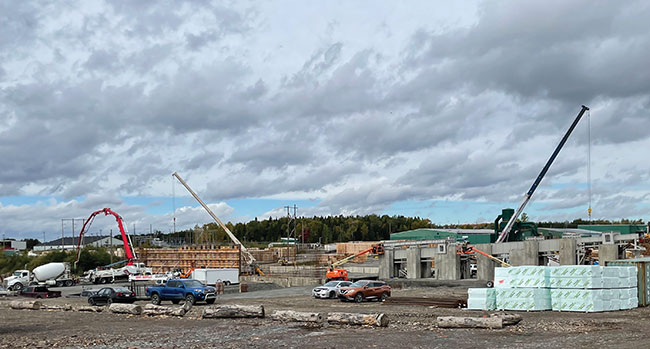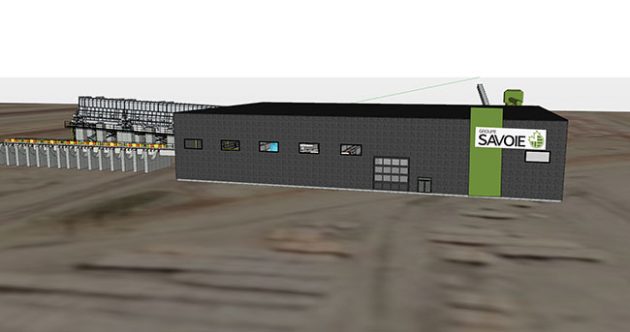
Features
Getting sorted: Groupe Savoie invests in new sorting plant
January 20, 2023 By Andrew Snook

Groupe Savoie has started construction on a project designed to literally sort out inefficiencies at their sawmill in Saint-Quentin, N.B.
The diverse forest products manufacturer has begun work on the construction of a new sorting plant for its hardwood pallet components sawmill, where the company has been salvaging hardwood pulpwood to chip a portion of the logs for the pulp and paper industry, while sawing the rest into pallet components for the adjacent pallet manufacturing plant.
Talks for the new sorting plant began in 2020.
“We had a lot of meetings, ordered lunch with the owner, the president, plant manager and the executive team, all those involved were around the table,” recalls Marco Turcotte, vice-president of Groupe Savoie’s pallet value stream. “We looked at different options to get a better flow in the mill. There was too much lost time dealing with logs that were destined to the chipper.”
Optimize and diversify
This is far from the first time Groupe Savoie has invested in improving efficiencies to protect its future. The largest employer in Saint-Quentin has been optimizing and diversifying its operations for decades.
The company started up in 1978 when Hector Savoie and his son, Jean-Claude, purchased Restigouche Hardwood Ltd. and Cedre Restigouche Ltd. After a massive fire destroyed the Restigouche Hardwood sawmill in 1980, the company re-focused the Cedre Restigouche sawmill to saw hardwood.
In 1984, the company began creating value-added products by assembling wooden pallets. Four years later, the company built the Savoie & Fils Inc. sawmill to salvage logs and hardwood pulpwood to produce pallet components.
Since that time, Groupe Savoie has added a hardwood component factory, a sawmill in Westville, N.S., a factory for kitchen cabinet components; another pallet plant in Moncton, N.B.; a wood pellet plant; and the launch of the Canawick ecological fuel line.
The current sorting process at the sawmill had some inefficiencies that Groupe Savoie wanted to address.
Currently, eight-foot-long pulp logs come to the mill that are put through a slasher outside that cuts the logs to four feet. The logs are then debarked with a Fuji King debarker and are sorted inside the mill. All the smaller and crooked material goes to the chipper, and when the proportion of small and crooked logs is too high, the mill runs idle; which is very costly having most employees waiting for logs to process. The salable logs then go to a twin or a chipper canter to be cut into pallet components.
The new sorting plant being constructed will be separate from the sawmill. The logs will be debarked then sorted. All material not suited for the sawmill will be chipped in the new plant.
The logs will go through an X-ray scanner, and all logs deemed unworthy for pallet production will go directly to the chipper. The good logs will go to sorting bins and are sorted according to their size to maximize the two sawing lines. The idea is to bring only good logs to the sawing lines and maximize production. This will enable the company to use more wood of pulpwood grade and eventually more pallets.
The new plant will be automated and will only need one operator per shift. A millwright will be on site to keep everything running smoothly.

Image rendering of Groupe Savoie’s new sorting plant.
Sourcing challenges
Due to the supply chain issues impacting companies around the globe, sourcing the equipment and contractors for the new sorting plant took some creative thinking on the part of Groupe Savoie’s leadership group.
“The equipment was hard to get on time. It’s not a full A to Z with one company. We had to design the plant here internally and do some research for every part of the sorting line to see who was able to supply parts of the line,” Turcotte says.
As of this fall, Groupe Savoie is working with eight different contractors and have ordered different types of equipment from several suppliers.
The company sourced a chipper from Kadant, chip screen from USNR, and the scanner from Springer-Microtec, as well as the log singulator.
All conveyers for handling chips are supplied by Vibrotech in Quebec. The building is built and erected by MQM Quality Manufacturing, based in New Brunswick. Altogether, there are a lot of moving parts to oversee.
“It gives us lots of headaches managing all the deliveries,” Turcotte says. “Managing delivery schedules is quite a challenge.”
The hope is to have the new plant up and running by April 2023.
Print this page